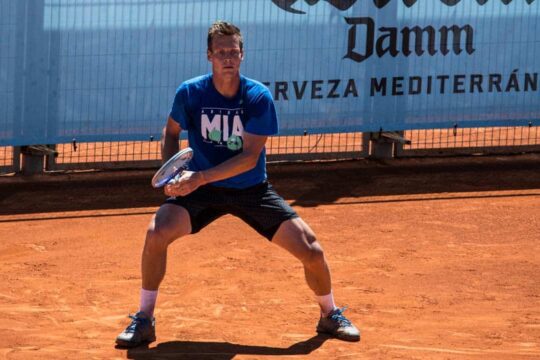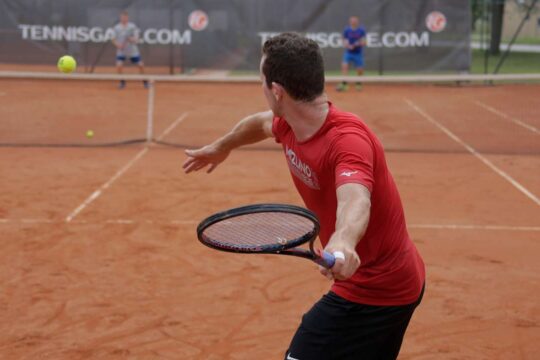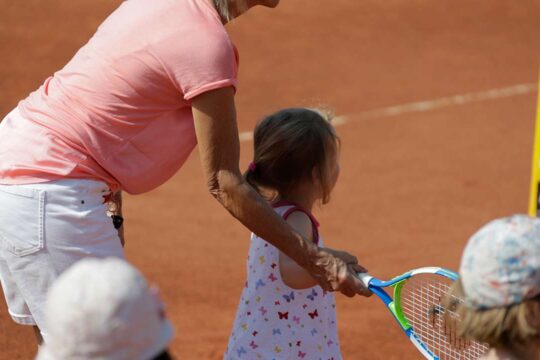Improving the Mental Skills of your Players

From the book Developing High Performance Tennis Players (Edgar Giffenig)
There are thousands of sport psychology books in the market dealing with this topic and offering advice to help athletes optimize performance, and any extended discussion about sport psychology techniques would be beyond the scope of the book. However, at the very least, a coach should constantly address these three areas to help players become better competitors:
- Focus
- Relaxation
- Competitive Environment
In tennis, two of the most important skills leading to a consistent level of performance are focus, and relaxation; specifically, watching the ball to contact and staying mentally and physically relaxed, regardless of the circumstances. Being able to do this regularly will eliminate two of the most common sources of mistakes.
It sounds simple, but in many instances, these two areas are not addressed with the level of importance they deserve. Many coaches and players fail to understand the significance of these elements and tend to look for the solution to their mistakes in other areas of the game, failing miserably in the end.
The most important goal for every player should be to eliminate any mistakes due to lack of focus on the ball or physical or mental stress. This goal should be ever present in all practices or match-situations and coaches should find ways to keep these concepts in the forefront of their programs.
Here are a few ideas on how to achieve this.
FOCUS
The success or failure of any stroke in tennis depends on the contact point. The big challenge for any player is to make contact with the ball in the middle of the racquet head, at precisely the right time. The only way to accomplish this regularly is with total concentration on the ball, especially as it moves closer and closer to the ideal contact point.
Most players do a relatively good job tracking the ball from the opponent’s side of the court to the bounce, but have a hard time maintaining focus as the ball approaches contact, resulting in unforced errors or loss of control. The problem is compounded in the following situations:
- Pressure situations, such as hitting a passing shot, returning a hard serve or on the full run.
- Situations where the player has extra time, such as facing a high slow volley, a high slow shot in the middle of the court or a “dinky” serve.
- Situations of transition, such as approaching the net.
- Serve. Coaches need to remind their players that a total commitment to the ball is not only appropriate for groundstrokes but also especially important on the serve, where perfect timing and coordination of the different body segments, the racquet and the ball are essential.
In all of these instances players tend to look up too early and fail to track the ball the contact point. These types of mistakes need to be eliminated through improvements in concentration and tracking skills.
Here are a few drills that will help.
Bounce-hit
Players rally or play points shouting “bounce” or “hit” every time, exactly, as the ball bounces or makes contact with the strings, forcing the players to keep their focus on the ball throughout the whole point or rally.
Grip Rally
Players rally with each other hitting high lobs but have to stop the ball with the grip before playing it back. Each player tries to stop the ball with the grip, holding the racquet upside down, from the racquet head, with both hands and keeping the grip at eye level to facilitate contact. They should, then, let the ball bounce once before hitting it over high and deep to their partner. By trying to contact the ball with the grip, players are forced to fully concentrate on the ball all the way to contact.
Butt Cap Rally
Players rally with each other hitting high lobs, but have to stop the ball with the butt cap before playing it back. Each player tries to stop the ball with the butt cap, holding the racquet upside down, from the racquet head, with both hands and keeping the grip at eye level to facilitate contact. They should then let the ball bounce once, before hitting it over, high and deep to their partner. By trying to contact the ball with the butt cap, players are forced to fully concentrate on the ball all the way to contact.
Grip return
On the return of serve it is very easy to lose the ball from the bounce to the racquet. Therefore, it may require extra attention. In this drill, players will position themselves to return serve but will hold their racquets upside down, from the racquet head, with both hands and will try to stop a ball served to them. They should not try to hit the ball, merely stop it. Once again, by trying to contact the ball with the grip, players are forced to fully concentrate on the ball all the way to contact.
RELAXATION
After failing to track the ball into the racquet, the second most common source of unforced errors is tension and anxiety.
The only way the body can perform up to its potential is during a state of calm intensity, totally engaged but loose and relaxed. All joints have to be able to move freely and only the muscles needed to perform the task at hand have to be called into action. Only then, will the body be able to heed the signals sent by the brain and execute the required action without interference.
Most players are not very efficient when swinging and use too much force and energy, negatively influencing their performance. Players need to allow their movements to flow by letting the body work efficiently, and that can only be achieved through constant attention. Players should continuously work on learning to hit the same shots with less effort by frequently asking themselves questions such as: Am I swinging the racquet or am I pushing it? Am I totally loose during the swing or not? Do I detect tension somewhere?
The answer to these questions will help players to identify areas of unnecessary tension, which they will then be able to address and eliminate.
It is important to note that the tension level of each player, for every stroke, is an automatic reaction and if the player does not consciously try to analyze every part of his body to detect any form of stress, he will never notice it. I have worked with many players who claimed to be relaxed when in reality were totally cramped up. Only through conscious effort, were these players able to identify their problem areas and create new habits that helped them develop increasingly smoother, fluid and consistent swings.
It is especially important to help players discover unwanted tension in strokes with which they have had difficulty in the past. A technically faulty shot usually results in the buildup of high, negative tension levels, and unless the player consciously works on reducing this anxiety level and muscular tension during that particular shot, the shot will continue to suffer, even as the technique improves.
Beside conscious analysis, there are also, many exercises that can be used to help players swing more efficiently, for example those I described in my book Developing High Performance Tennis Players such as alternating swinging a HEAVY RACQUET and a regular racquet, swinging the racquet holding it with THREE FINGER and swinging at 3 speeds (slow, medium and fast) without increasing body tension. However, at the very least, every coach should make sure that the players learn to hold the racquet as loosely as possible in every swing. It is a huge step in the right direction. A smooth swing can only be achieved with a loose grip. Try it and you will be surprised by the results.
COMPETITIVE ENVIRONMENT
The next statement is probably one of the most important concepts in the whole book: “No player will reach his potential outside a competitive environment, because the only way to truly learn to thrive under the stress of competition is to constantly face it.” As simple as that! If you want to develop high performance players you have to create an environment where players are continually battling. The most important action any coach can take to develop mentally tough players is to include frequent match and tournament play in the schedule and to create a very competitive practice setting full of competitive technical drills, competitive tactical drills and other drills specifically designed to force a player to deal with adversity.




